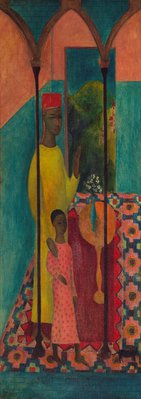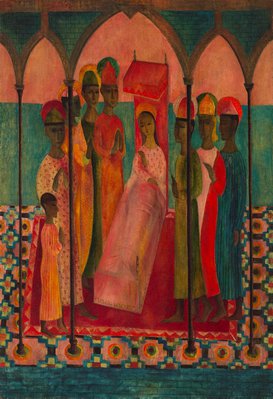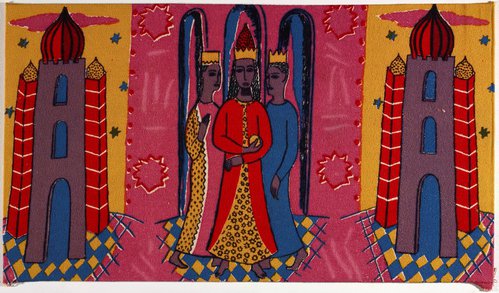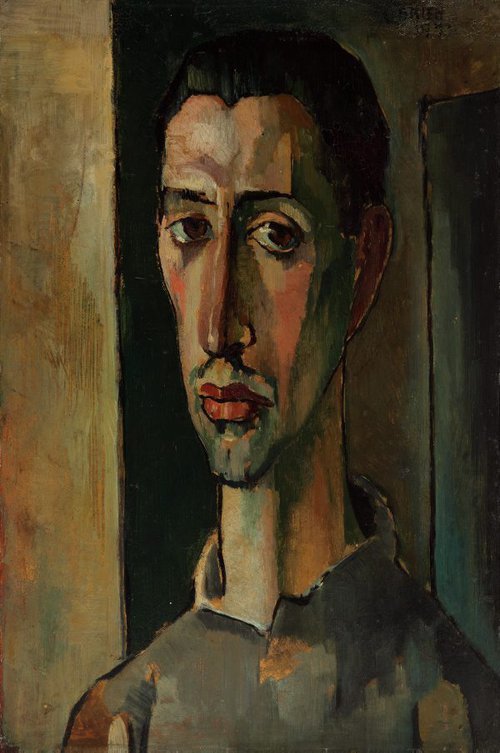Title
The Dormition of the Virgin
(1947)
Artist



-
Details
- Other Title
- Triptych
- Place where the work was made
-
Sydney
→
New South Wales
→
Australia
- Date
- (1947)
- Media category
- Painting
- Materials used
- triptych: oil on canvas laid on hardboard
- Dimensions
-
114.9 x 162.7 cm overall
:
a, 93 x 34 cm, left panel
b, 101.2 x 70.3 cm, centre panel
c, 93 x 34 cm, right panel
- Signature & date
inscr l.l. corner left panel / l.r. corner centre panel / l.r. corner right panel, dark blue oil "O'BRIEN"
- Credit
- Gift of the Hall Best family in memory of Marion Hall Best 2020. Donated through the Australian Government's Cultural Gifts Program
- Location
- Not on display
- Accession number
- 154.2020.a-c
- Copyright
- © Estate of Justin O'Brien
- Artist information
-
Justin O'Brien
Works in the collection
- Share
-
-
About
Justin O'Brien was a significant painter of the figurative traditions that developed in Sydney in the post-war period. Growing up in south-western Sydney he left school at the age of 14 to begin private lessons with Edward M Smith, a teacher at East Sydney Technical College who painted portraits and religious themes. O’Brien drew from anatomical casts and painted still-life arrangements set by his teacher. After four years of study O’Brien taught at various convent schools and became involved in the NSW branch of the Contemporary Art Society.
Enlisting in 1940 and serving overseas, O’Brien was captured by the German army and spent almost three years in a prison camp, first near Athens and then in Poland. Serving with the medical corp he was exposed to the severely injured and dying and also witnessed mass starvation and mass burials in Greece. These traumatic experiences informed subjects of his paintings from the late 1940s, although he masked the devastation in his simplified style and in his use of biblical themes.
On his return to Australia he became involved with a group of artists including Lloyd Rees, Jeffrey Smart, Jean Bellette, Paul Haefliger, David Strachan, Sali Herman, Eric Wilson, and others who became known as the Merioola Group. Active in the 1940s and early 1950s, the group had disparate artistic styles and were linked through their living arrangements, with many of them living together in a mansion converted into a boarding house called 'Merioola' at Woollahra.
In 1947 O'Brien became the art master at Cranbrook School in Sydney. His students included Peter Kingston and Martin Sharp, who later became well-known artists. The steady income from this position gave him financial freedom and he spent sabbaticals in Europe, painting and studying masterpieces by his heroes Duccio, Fra Angelico, Paolo Uccello and Piero di Cosimo.
O'Brien remained at the school until 1966 before he left Australia to live permanently in Italy, though he continued to return regularly to exhibit in Australia. O'Brien's explorations of religious subjects were inspired by the work he saw in Europe but were his attempt to translate them into a 20th century idiom.
'The Dormition of the Virgin' depicts the Virgin Mary on her death bed, surrounded by the Apostles, typical iconography in religious painting. As she prepares to ‘fall asleep’ or die, she is in a state of calm and spiritual peace and will die without suffering. Painted in O’Brien’s characteristically bright palette and his elongated figurative style for which he was well known, it was influenced by O’Brien’s affinity for the art of the Sienese 'trecento' (fourteenth century). The triptych format with a slightly larger central panel references a church altarpiece.
-
Places
Where the work was made
Sydney
-
Exhibition history
Shown in 2 exhibitions
Exhibition of oils and drawings by Justin O'Brien (1947), David Jones' Art Gallery, Sydney, Sydney, 23 Oct 1947–01 Nov 1947
Justin O'Brien: the sacred music of colour (2010), Art Gallery of New South Wales, Sydney, 18 Dec 2010–27 Feb 2011
-
Bibliography
Referenced in 1 publication
-
Barry Pearce and Natalie Wilson, Justin O'Brien: the sacred music of colour, Sydney, 2010, 41 (colour illus.) in situ, 48 (colour illus.), 49 (colour illus.) detail, 158, 182. cat.no. 22
-




